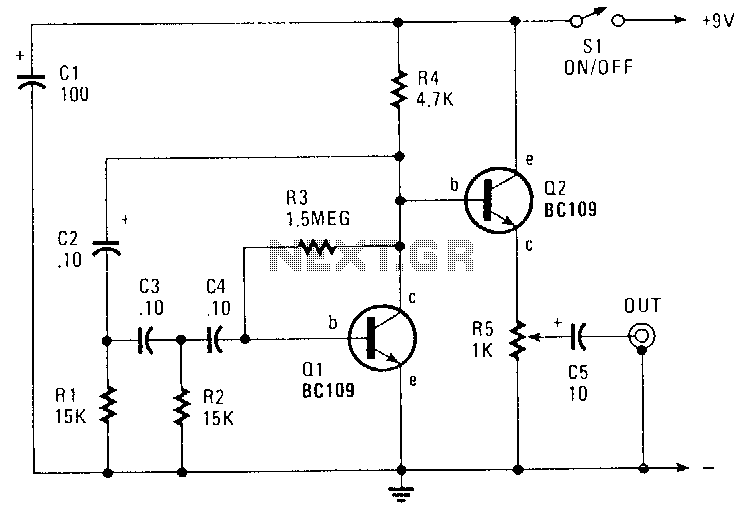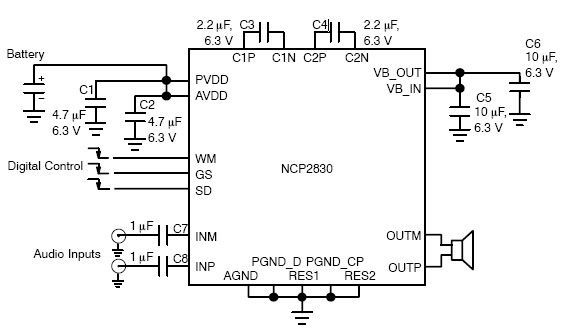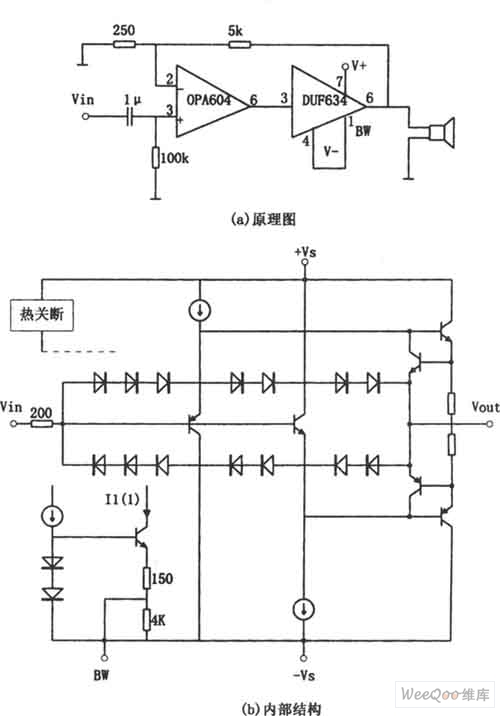
AUDIO OSCILLATOR

A Wien bridge oscillator generates sine waves with minimal distortion. It produces zero phase shift at a specific frequency (f=1/2 RC), which is the frequency of oscillation. Stable oscillation is achieved when the loop gain is maintained at unity at the oscillation frequency. This control is accomplished through the positive temperature coefficient of a small lamp, which regulates gain (Rf/RLAMP) as the oscillator varies its output. The circuit features four frequency bands ranging from approximately 15 Hz to 150 kHz, with continuously variable frequency within each band using ganged 20 k ohm potentiometers. The oscillator consumes about 4.0 mA from 9-V batteries, providing an output of 4 to 5 V with a 10 k ohm load, while the feedback resistor (Rf) is set approximately 5% below the clipping point. The center arm of the 5 k ohm output potentiometer serves as the output terminal. To connect the oscillator to a DC circuit, a capacitor should be placed in series with the output lead.
The Wien bridge oscillator is a highly regarded circuit in electronics for its ability to produce low-distortion sine waves. At its core, the oscillator utilizes a bridge configuration that allows for fine-tuning of frequency and amplitude. The key components include resistors, capacitors, and a variable gain element, which in this case is a small incandescent lamp. This lamp's resistance increases with temperature, providing a negative feedback mechanism that stabilizes the gain and ensures that the loop gain remains at unity during oscillation.
The frequency of oscillation is determined by the resistive and capacitive components in the circuit, specifically following the formula f = 1/(2πRC). The design incorporates four distinct frequency bands, allowing users to select from a range of 15 Hz to 150 kHz. Each band is adjusted using 20 k ohm potentiometers that are ganged together, enabling simultaneous control over the frequency while maintaining the desired output characteristics.
The output of the Wien bridge oscillator is designed to deliver voltages between 4 to 5 V under a load of 10 k ohm. This output level is crucial for interfacing with other circuits and ensuring that the oscillator can effectively drive loads without significant distortion. The feedback resistor (Rf) is strategically set to about 5% below the clipping point to prevent distortion and maintain a clean sine wave output.
In practical applications, the output from the oscillator can be coupled to other circuits, including DC circuits. To achieve this, a coupling capacitor is recommended to block any DC offset while allowing the AC signal to pass through. The output terminal is conveniently located at the center arm of the 5 k ohm output potentiometer, facilitating easy access for connections to external devices or circuits.
Overall, the Wien bridge oscillator is a versatile and efficient circuit for generating sine waves across a wide frequency range, making it valuable in various electronic applications, including audio synthesis, signal processing, and testing equipment.A Wien bridge oscillator produces sine waves with very low distortion level. The Wien bridge oscillator produces zero phase shift at only one frequency (f=1/2 RC) which will be the oscillation frequency. Stable oscillation can occur only if the loop gain remains at unity at the oscillation frequency. The circuit achieves this control by using th e positive temperature coefficient of a small lamp to regulate gain (Rf/RLAMP) as the oscillator attempts to vary its output. The oscillator shown here has four frequency bands covering about 15 Hz to 150 kHz. The frequency is continuously variable within each frequency range with ganged 20 k ohm potentiometers.
The oscillator draws only about 4. 0 mA from the 9-V batteries. Its output is from 4 to 5 V with a 10 k ohm load and the Rf (feedback resistor) is set at about 5% below the point of clipping. As shown, the center arm of the 5 k ohm output potentiometer is the output terminal. To couple the oscillator to a dc type circuit, a capacitor should be inserted in series with the output lead.
🔗 External reference
The Wien bridge oscillator is a highly regarded circuit in electronics for its ability to produce low-distortion sine waves. At its core, the oscillator utilizes a bridge configuration that allows for fine-tuning of frequency and amplitude. The key components include resistors, capacitors, and a variable gain element, which in this case is a small incandescent lamp. This lamp's resistance increases with temperature, providing a negative feedback mechanism that stabilizes the gain and ensures that the loop gain remains at unity during oscillation.
The frequency of oscillation is determined by the resistive and capacitive components in the circuit, specifically following the formula f = 1/(2πRC). The design incorporates four distinct frequency bands, allowing users to select from a range of 15 Hz to 150 kHz. Each band is adjusted using 20 k ohm potentiometers that are ganged together, enabling simultaneous control over the frequency while maintaining the desired output characteristics.
The output of the Wien bridge oscillator is designed to deliver voltages between 4 to 5 V under a load of 10 k ohm. This output level is crucial for interfacing with other circuits and ensuring that the oscillator can effectively drive loads without significant distortion. The feedback resistor (Rf) is strategically set to about 5% below the clipping point to prevent distortion and maintain a clean sine wave output.
In practical applications, the output from the oscillator can be coupled to other circuits, including DC circuits. To achieve this, a coupling capacitor is recommended to block any DC offset while allowing the AC signal to pass through. The output terminal is conveniently located at the center arm of the 5 k ohm output potentiometer, facilitating easy access for connections to external devices or circuits.
Overall, the Wien bridge oscillator is a versatile and efficient circuit for generating sine waves across a wide frequency range, making it valuable in various electronic applications, including audio synthesis, signal processing, and testing equipment.A Wien bridge oscillator produces sine waves with very low distortion level. The Wien bridge oscillator produces zero phase shift at only one frequency (f=1/2 RC) which will be the oscillation frequency. Stable oscillation can occur only if the loop gain remains at unity at the oscillation frequency. The circuit achieves this control by using th e positive temperature coefficient of a small lamp to regulate gain (Rf/RLAMP) as the oscillator attempts to vary its output. The oscillator shown here has four frequency bands covering about 15 Hz to 150 kHz. The frequency is continuously variable within each frequency range with ganged 20 k ohm potentiometers.
The oscillator draws only about 4. 0 mA from the 9-V batteries. Its output is from 4 to 5 V with a 10 k ohm load and the Rf (feedback resistor) is set at about 5% below the point of clipping. As shown, the center arm of the 5 k ohm output potentiometer is the output terminal. To couple the oscillator to a dc type circuit, a capacitor should be inserted in series with the output lead.
🔗 External reference





